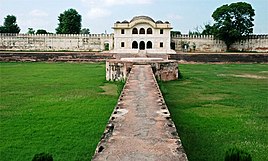
Back Fatehgarh Sahib Catalan Fatehgarh Sahib Spanish Fatehgarh Sahib French ફતેહગઢ સાહિબ Gujarati फतेहगढ़ साहिब Hindi Fatehgarh Sahib Italian ಫತೇಘರ್ ಸಾಹಿಬ್ Kannada Fatehgarh Sahib Malagasy फतेहगढ साहिब Marathi Fatehgarh Sahib (district) Dutch
Fatehgarh Sahib | |
|---|---|
City | |
Clockwise from top: Gurdwara Fatehgarh Sahib, Rauza Sharif, Aam Khas Bagh, Jahaz Haveli, Khanda Museum. | |
| Coordinates: 30°38′50″N 76°23′35″E / 30.64722°N 76.39306°E | |
| Country | |
| State | Punjab |
| District | Fatehgarh Sahib |
| Named for | Baba Fateh Singh, son of Guru Gobind Singh |
| Elevation | 246 m (807 ft) |
| Population | |
| • Total | 50,788 |
| Languages Punjabi | |
| • Official | Punjabi |
| Time zone | UTC+5:30 (IST) |
| PIN | 140406,140407 |
| Telephone code | +91-1763 |
| Vehicle registration | PB-23 |
| Website | www |
| [1] | |
Fatehgarh Sahib (Punjabi pronunciation: [fə.t̪éː.gə́ɽᵊ sä́ːbᵊ]) is a city and a sacred pilgrimage site of Sikhism in the north west Indian state of Punjab.[1][2] It is the headquarters of Fatehgarh Sahib district, located about 5 kilometres (3.1 mi) north of Sirhind. Fatehgarh Sahib is named after Fateh Singh, the 7-year-old son of Guru Gobind Singh, who was seized and buried alive, along with his 9-year-old brother Zoravar Singh, by the Mughals under the orders of governor Wazir Khan during the ongoing Mughal-Sikh wars of the early 18th century.[1][2] The town experienced major historical events after the martyrdom of the sons in 1705, with frequent changes of control between the Sikhs and Mughals.[1][3]
The town features historic Gurdwaras, including the underground Bhora Sahib marking the location where the two boys refused to convert to Islam and fearlessly accepted being bricked alive.[1][4] In contemporary times, the town is the site of educational institutions such as the SGPC run Guru Granth Sahib University and Baba Banda Singh Bahadur Engineering College.[5]
- ^ a b c d Gurmukh Singh (2009), Fatehgarh Sahib, Encyclopedia of Sikhism, Editor in Chief: Harbans Singh, Punjab University
- ^ a b W. H. McLeod (2009). The A to Z of Sikhism. Scarecrow. p. 65. ISBN 978-0-8108-6344-6.
- ^ H. S. Singha (2000). The Encyclopedia of Sikhism (over 1000 Entries). Hemkunt Press. pp. 186–187. ISBN 978-81-7010-301-1.
- ^ Harish Jain (2003). The Making of Punjab. Unistar. p. 289.
- ^ Pashaura Singh; Louis E. Fenech (2014). The Oxford Handbook of Sikh Studies. Oxford University Press. p. 555. ISBN 978-0-19-100412-4.






